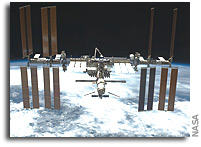NASA International Space Station Lead Increment Scientist’s Weekly Highlights: First Two Weeks of July 2011

(Highlights: First Two Weeks of July 2011) — On July 12 the Material International Space Station Experiment-8 (MISSE-8) was installed on the outside of the station. MISSE-8 tests a variety of materials to determine the effects of the space environment such as extreme temperature ranges, solar radiation and atomic oxygen to name a few. This investigation is scheduled to remain attached to the exterior of the station for the next couple of years.
The spider habitat was packed for return on STS-135 for the Commercial Generic Bioprocessing Apparatus Science Insert – 05 (CSI-05): Spiders, Fruit Flies and Directional Plant Growth. Results from CSI-05 may help scientists more clearly understand how different organisms are affected by the microgravity environment.
Three crew members performed sessions with Validation of Procedures for Monitoring Crew Member Immune Function (Integrated Immune). Changes in the immune system are monitored by collecting and analyzing blood and saliva samples from crew members during flight and blood, urine, and saliva samples before and after spaceflight. It is designed to develop an immune monitoring strategy for effective countermeasures which will safeguard crew health on long-duration missions. The data collected may also lead to a greater understanding of how the immune system is affected by different factors from stress to the environment. This data could potentially be used to help develop new treatments and preventative measures for immune dysfunctions.
Three crew members completed runs with the Psychomotor Vigilance Self Test (Reaction Self Test). The experiment is a portable five-minute reaction time task that allows crew members to monitor the daily effects of fatigue on performance while aboard the station. It helps crew members to objectively identify when their performance capability is degraded by various fatigue-related conditions that can occur as a result of station operations and time in space.
To date, the Alpha Magnetic Spectrometer – 02 (AMS-02) has collected data on more than 2 billion events and continues to collect data from 40 million cosmic rays daily. The AMS-02 uses the unique environment of space to advance knowledge of the universe and lead to the understanding of the universe’s origin by searching for antimatter, dark matter and measuring cosmic rays.
The Hyperspectral Imager for the Coastal Ocean (HREP-HICO) Experiment Payload has taken 3,510 images to date, including recent images of the coast of Portugal, the Aral Sea, the English Channel and the coast of Italy near Venice. The experiment analyzes the water clarity, chlorophyll content, water depth and ocean or sea floor composition for naval purposes.
The Japan Aerospace Exploration Agency completed two successful runs with the Dynamism of Auxin Efflux Facilitators, CsPINs, Responsible for Gravity-regulated Growth and Development in Cucumber (CsPINS) experiment. CsPINs studies how plants sense gravity as an environmental signal and use it for governing their morphology and growth orientation.
Vic Cooley, Lead Increment Scientist Expedition 27/28








